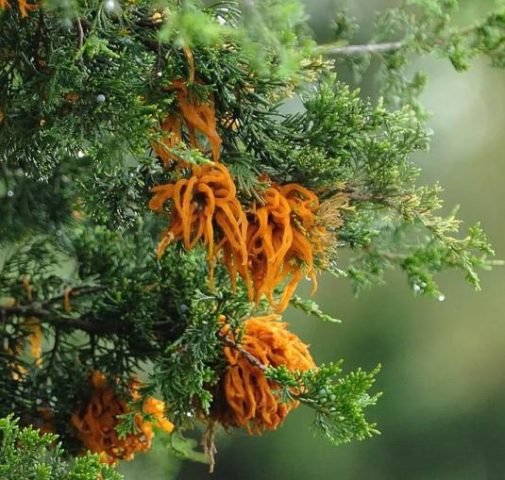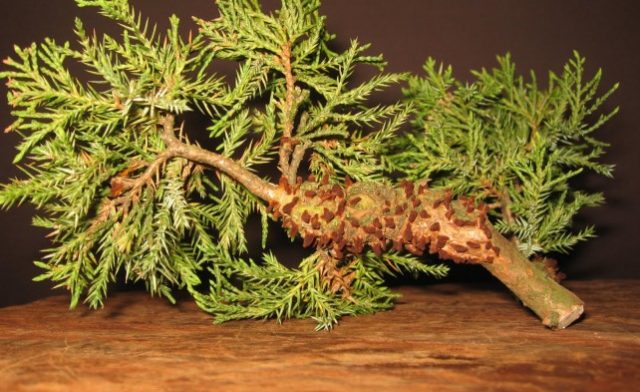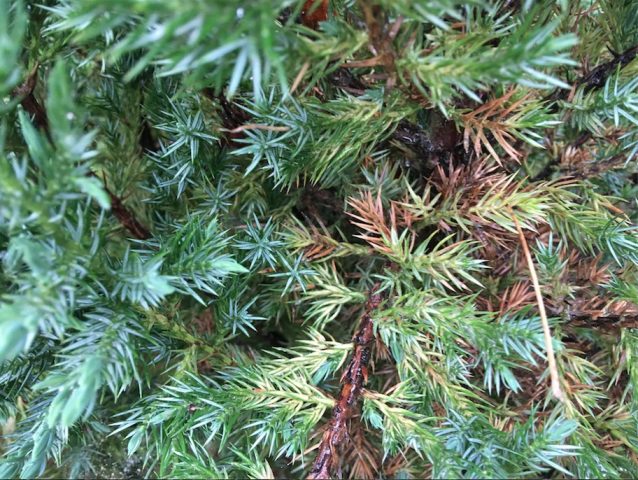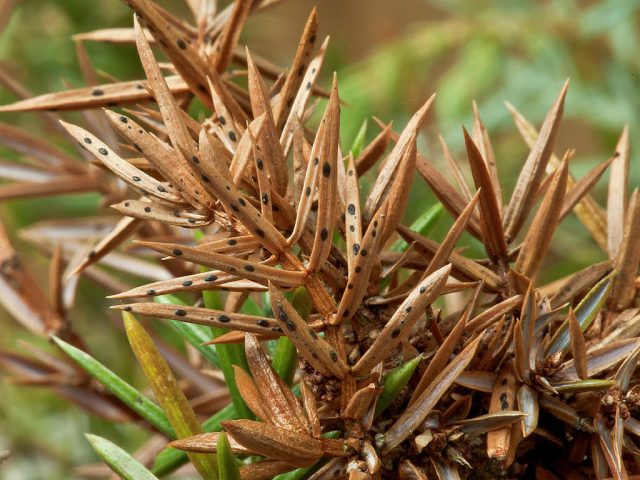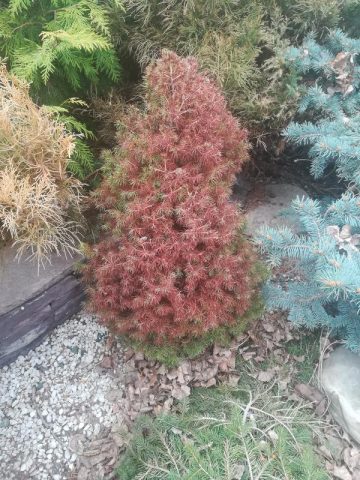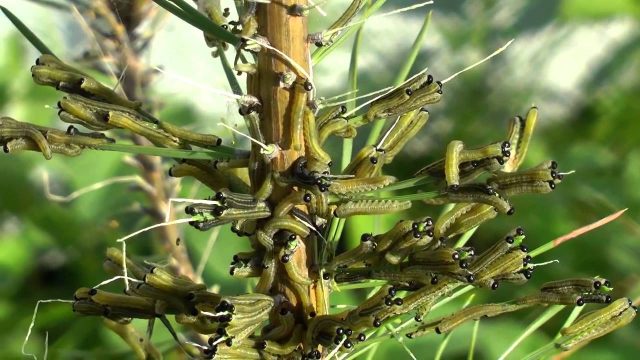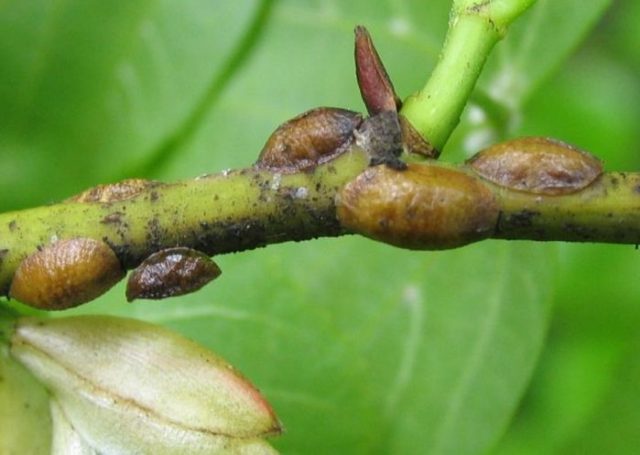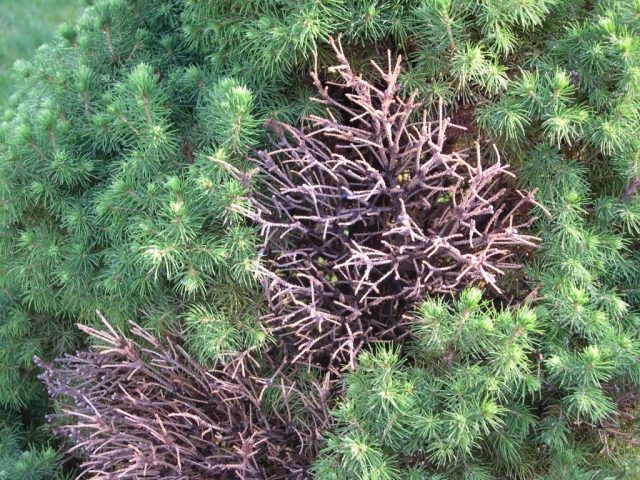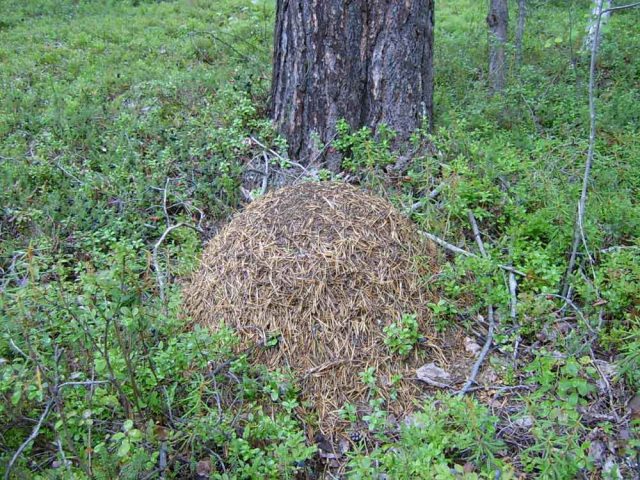Content
Juniper is a popular culture in landscape design, widely used for decorating personal plots and landscaping cities. There are more than a hundred species and varieties of this evergreen - trees of various shapes and sizes, medium-sized, dwarf and creeping shrubs. Junipers go well with deciduous trees, flower beds, they can be used to create various compositions. Undemanding to the care and composition of the soil, they can be affected by pathogenic microflora and parasites. How to identify plant diseases and harmful insects, what drugs to treat a plant for treatment and prevention will be described later.
Juniper diseases and their treatment
Juniper is rarely damaged by diseases and pests. This is a strong plant that is not afraid of adverse climatic conditions. Most of all, the juniper is susceptible to infection with diseases and pests in the spring, until warm weather is established. At this time, the juniper is harmed by sudden changes in temperature, which causes frostbite of the roots or burns and drying of the crown. The culture has a hard time tolerating stagnation of moisture in the roots, which forms after the snow melts, or, on the contrary, a long drought after a snowless winter. As a result, the immunity of the juniper weakens, it becomes defenseless against various pathogens. Imperfect young plants are also susceptible to infection. It is very difficult to visually diagnose juniper diseases, common symptoms for them are yellowing, browning and dying of needles, drying out of branches, thinning of the crown. The following will provide an overview of the most common juniper diseases with photos and recommendations for their treatment.
Rust
Juniper rust disease is caused by the fungus Gymnosporangium, which requires two host plants for its full life cycle. Juniper is a winter host, Rosaceae (apple, pear, quince) are summer hosts. The fungus lives on branches, trunk, needles and cones, causing the branches to die, drying out and cracking the bark. The disease manifests itself in the spring: brown formations form in the wounds of the plant, which, after rain or dew, swell and become covered with mucus. Spores germinate from them, forming an orange bloom. The wind carries them to fruit trees. They parasitize the leaves, form growths, on which spores mature, subsequently affecting the juniper. Infection occurs within a radius of 6 km.
In order to control the disease, you should:
- prune infected branches in early spring and winter;
- do not plant both host plants side by side;
- treat juniper from rust with Arcerida solution, Bordeaux liquid.
Favorable conditions for the spread of the disease are dampness and coolness. During the period of prolonged rains, you should regularly inspect the juniper. Having found orange growths on the aerial parts of the plant, you need to hurry to process it.
Juniper rust disease is shown in the photo:
Bark necrosis
This juniper disease is also called nectriosis or nectrious cancer. The causative agent - the fungus Netctriacucurbitula, penetrates the wound on the tree, resulting from mechanical damage to the bark.The disease is manifested by the formation of local and annular necrosis of branches and trunks without discoloration. In spring, brick-red convex smooth pads up to 2 mm in diameter appear in cracks in the bark. These are the stroma - the plexus of the mycelium, on the surface of which spores develop. Over time, they turn black and dry out. Subsequently, the needles begin to turn yellow, the bark is torn away, the branch dies, the juniper dies. In order to prevent the development of a disease on a plant, you need to take measures:
- remove diseased branches;
- thin out thickened plantings;
- treat with a copper-containing preparation.
When destroying a plant, it is important to thoroughly clean the soil from plant residues and treat it with the fungicide "Quadris", "Tilt" - this will prevent re-infection with the disease.
Biotorella cancer
The disease occurs in the same way as nectriosis - the spores of the fungus Biatorelladifformis settle in the damaged bark and wood of the juniper. The penetration of infection is facilitated by the activity of insects that destroy the integrity of the bark. The disease spreads quickly, causing necrosis of the bark: its browning, drying, cracking. In the future, the wood gradually dies off, longitudinal oval wounds are formed in it. Ulcers are deep, stepped, with ragged edges, more concentrated in the middle part of the branches and trunk, more often on the northern side. The disease affects junipers growing in unfavorable conditions, strongly weakens them, leading to drying out of the crop, and a decrease in resistance to snow break. For treatment you should:
- cut out the affected parts of the plant;
- treat the juniper with an antifungal agent, paying special attention to the cut sites.
Alternaria
If the branches and needles of a juniper become brown, covered with a black bloom, this indicates an infection with the fungus Alternariatenus Nees. In the future, the needles crumble, the branches die off. To combat the disease, the juniper must be treated with the preparations "HOM" or "Abiga-Peak", Bordeaux liquid. The affected branches must be removed by lubricating the cut sites with garden varnish or oil paint on drying oil.
Fusarium
This juniper disease is also called tracheomycotic wilting. It affects plants of any age. The causative agents are anamorphic fungi of the genus Fusarium that live in the soil. They penetrate first into the roots of the juniper, causing their partial decay, then into the vascular system, preventing the movement of juices. By the time the disease manifests itself in the aerial part, the plant will already be heavily affected by the disease. The presence of whitish or reddish spores of the fungus in the area of the root collar and a dark ring on the cut of the branch will help to reveal the latent disease of the juniper.
At the first symptoms, the soil should be treated with solutions of biological products "Fitosporin-M", "Agat-25K", "Gamair", "Fundazol", "Alirin-B". You can try to save the juniper from the disease by cutting out the affected branches and treating the cuts with copper sulfate.
Schütte
Schütte is a group of diseases affecting conifers. It is manifested by redness, drying out and withering away of the needles. The reason is pathogenic fungi of various genera. On the juniper, 2 types of shute appear.
Brown
The causative agent of the disease is the Herhpotrichianigra mushroom. Infection occurs in autumn, development - in winter under a snow cover at a temperature not lower than + 0.5 ˚С. The disease manifests itself in the spring, in March-April. After the snow melts, yellowed needles are visible on the branches, covered with a snow-gray bloom resembling a cobweb.Over time, it darkens, becomes black-brown, dense, "glues" the needles. The needles turn brown, but do not crumble, held together by the mycelium. In the fall, rounded spores appear on them.
Juniper shute
The disease is caused by the fungus Lophodermium macrosporum. Symptoms: in the spring of last year, the needles acquire a yellow-brown color and do not crumble for a long time. By the end of summer, it is overgrown with mushrooms up to 1.5 mm in diameter.
To treat both types of shute, you need to take the same measures:
- cut out diseased parts of the plant;
- treat with fungicides "Strobi", "Skor", "Ridomilgold", colloidal sulfur.
Juniper pests and control
Pests attack the juniper to a lesser extent than other conifers, there are not so many insect species that have adapted to the specifics of feeding on it. However, their vital activity can lead to the loss of decorativeness and death of the plant. Parasites that harm the juniper are divided into sucking and needle-gnawing. It is important to identify the infection at an early stage, treat the plant in a timely manner in order to prevent insects from multiplying and causing severe harm.
Juniper sawfly
The adult sawfly has a green color, the head is brown-green. Larvae, caterpillars, green, with stripes on the body. They eat pine needles and young shoots. Lives in the ground, in a near-trunk circle. The fight against insects consists in digging the soil in the root zone, destroying the larvae and nests by hand, using glue belts. For the best result, the plant should be treated with Bi-58 and Kinmix insecticides.
Juniper Scale
It lives in needles and cones. Larvae of light yellow color, up to 1.5 cm in size, suck juices from the bark. This leads to its death, infection with fungal spores, a decrease in immunity and a slowdown in the growth of juniper. In the fight against them, 0.2% solution of "Karbofos" is effective. If last year there were already problems with the scabbard, in the spring the juniper must be treated as a preventive measure.
Spruce spider mite
His presence is indicated by the cobweb, densely entangling the branches of the juniper, yellow spots on the needles, its shedding. The insect reproduces very quickly: it reproduces up to 4 generations per season. During the growing season, it can destroy the plant, especially young seedlings. For the destruction of the spider mite, it is recommended to treat the culture with the acaricides "Sumiton", "Aktellik", "Karate".
Pine moth
The moth is a lepid-winged butterfly that destroys juniper needles in the summer-autumn period. Wings of males are dark brown, females are red-brown with whitish or yellowish spots. Caterpillars are green at first with a yellow head, later become blue-green or yellow-green with 3 longitudinal white stripes. It multiplies vigorously in hot dry summers and warm autumn. In October, the larvae descend into the litter, where they pupate and hibernate. Infection is diagnosed by inspection: eaten grooves and notches appear on the needles.
Larvicides are effective against larvae: "Methyl-nirofos", "Bayteks", "Arsmal", "Parisian Green". To treat plants against moth, you should use the products only in overalls and with the use of respiratory protection. Early autumn frosts can completely wipe out their population on junipers.
Gall midges
Gall midges are small mosquitoes up to 2.2 mm in length. As a result of the bites of the larvae (yellow-orange), cone-shaped galls appear, consisting of 3-4 whorls of needles. Galls are used by insects for food and shelter from entomophagous predators. As the larvae grow, the tops of the needles bend outward.Treatment: treat with drugs "Fufanon", "Actellik", "Commander", "Iskra", "Intavir".
Ants
Ants are equally good and bad. They loosen and structure the soil, eat the larvae of harmful insects, enrich the soil with organic matter and humus. A significant harm that comes from them is the cultivation of aphids on the aerial parts of the juniper and in the roots. The plant gets damaged, which slows down its development and growth. The activity of ants can lead to the death of a juniper. Ants also harm by carrying diseases from plant to plant. To get rid of insects, it is necessary to find an anthill, treat it with the preparations "Actellik", "Fufanon".
Aphid
Small wingless brown insect with two longitudinal stripes on the back. It feeds on juniper juices, weakening it. Young shoots and seedlings are especially affected. The fight against aphids begins with the destruction of ant nests. For best results, the juniper should be treated with poisonous compounds:
- anabasine sulfate solution (20 g per bucket of water);
- Rogor;
- Mospilan;
- "Decis";
- "Confidor;
- "Calypso".
Also, against aphids, juniper can be treated with soapy water (250 g per 5 liters of water). When processing the crown, care must be taken that the composition does not fall into the root zone.
Preventive actions
Disease is easier to prevent than to cure. Preventive measures taken in a timely and regular manner can ensure the health of the juniper and protect it from diseases and pests. Juniper care is based on:
- Compliance with the rules of agricultural technology - site selection, soil composition, mulching, loosening, top dressing.
- Timely application of fertilizers and immunomodulators. "Super-humisol", "Epin-extra", "Siliplant", "Nikfan" have proven themselves well as root and foliar dressings.
- Regular sterilization of garden tools, soil, seedling containers.
- Liming of acidified soils. Excessive acidity of the soil contributes to the occurrence of fungal and viral diseases.
- Adequate nutrition of juniper, which forms immunity, sufficient intake of potassium, phosphorus, nitrogen.
- Using healthy planting material, carrying out quarantine measures for new plants.
- Destruction of harmful insects - carriers of diseases.
- Soaking roots before planting in Fitosporin, Vitaros, Maxim.
Favorable conditions for the development of diseases are thickened plantings, excessive shading, high humidity, soil acidity. When choosing a site for planting junipers, you need to choose lighted and ventilated areas with light, well-drained soil. For the prevention of diseases, the plant should be treated twice a year with solutions with a high copper content, colloidal sulfur, systemic fungicides. The removed branches, bark and needles that fall off during an illness must be burned.
Conclusion
Juniper diseases occur as a result of a plant being in unfavorable conditions, initially impairing its development. In this case, the gardener needs to pay increased attention to the culture - to provide adequate nutrition, loosen the soil, remove weeds, inspect for the appearance of parasites and pathogenic microflora, attract beneficial insects to the site. Then the juniper will be a real decoration of the garden for many years.

